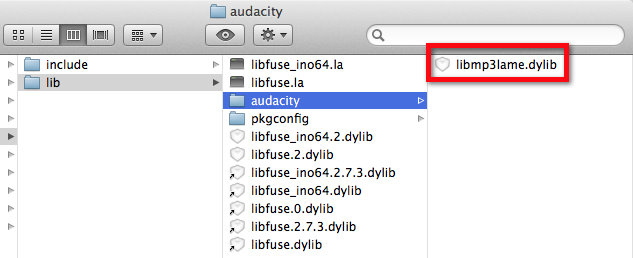
Every once in a while, when writing Audacity installation tutorials we noticed that we weren’t required to manually install the LAME MP3 Encoder, even after (fully?) uninstalling Audacity from our Mac computers.
For a minute there, we even thought that something had changed and that the popular MP3 encoding software was somehow included in the installation. Not the case.
What was happening was that the location LAME was installed to was actually a hidden folder and wasn’t showing up in Finder search queries.
After a bit of investigation, we discovered a very helpful post that made some genius-level suggestions on how to locate this file/folder and remove it completely from our Mac.
Basically, we had to open a Terminal window, enter a one-line command and voila — there was the file — ready for deletion!
For those looking to resolve the same issue, here are the steps, broken down as simply as can be:
Step 1: Open Terminal Window
If you’re not familiar with the Terminal utility on your Mac, don’t worry.
It’s a lot like MS-DOS (if you are familiar, you’ve just dated yourself, lol). If you’d like to get geeky with Terminal, Mac|Life does a great job with this archived post.
The Terminal program can be launched by opening Applications >> Utilities >> Terminal.
You should see a small window open up, looking like this:

Step 2: Enter Command
The folder containing the hidden LAME .dylib file for standard installations will be as follows:
/usr/local/lib/audacity/
This location can be opened by entering the following command into Terminal:
“open -a Finder /usr/local/lib/audacity/” (don’t include the parenthesis)
After entering the info above, your Terminal window should look like this:
![]()
Notice how nothing happened? That’s because we haven’t hit the Return/Enter key yet. Do so, and you should see the hidden folder appear as such:

Simply drag + drop the libmp3lame.dylib file to the Trash or Right-Click >> Move to Trash and it will be as if LAME had never been installed.
Granted, there aren’t many real-world applications, or needs, to remove LAME once installed, it is however quite helpful to know that if there are hidden files or folders residing on your computer that you may have the need to access, this is a superb way of doing so.
Did you find the above process helpful? Were you able to follow-along? Please let us know!
Comment below and connect with us for daily updates!
- Follow AudioAcrobat on Twitter
- Become a fan on Facebook
- Join our group on LinkedIn
- Subscribe to AudioAcrobat RSS
Want to learn more about AudioAcrobat? Go ahead, give it a try yourself by signing up for a 30 day Free Trial or join one of our FREE Training Classes without signing up for squat. Already have an account? Login HERE.
Did you know that AudioAcrobat has a built-in affiliate referral program? Earn 33% commissions, monthly!
Coming up next … #FolowFriday!



